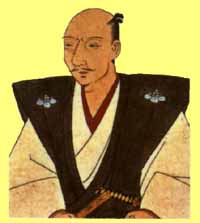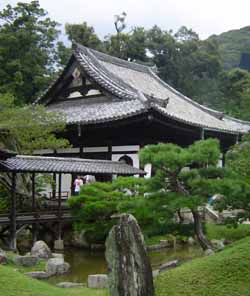 |
|||||
 |
|||||
 |
|||||
 |
|||||
 |
|||||
 |
|||||
 |
|||||
 |
|||||
 |
|||||
 |
|||||
 |
|||||
 |
|||||
 |
|||||
 |
|||||
Azuchi-Momoyama Period1573-1603 |
|
||||||||||||||||||||||||||||||||||||||||||||||||||||||||||||||||||||||||||||||||||||||||||||||||||
ODA NABUNAGA | TOYOTOMI HIDEYOSHI | CHANGES | TOKYGAWA
 The
Azuchi-Momoyama Period begins with shortly after the capture of Kyoto in 1568
by Oda Nobunaga (at left). The period itself is named for the castles that Nobunaga
and his successor Toyotomi Hideyoshi lived in. Nobunaga lived in Azuchi castle
while Hideyoshi lived in Momoyama castle. By 1573, he had overthrown the Muromachi
shogunate. Although, Nobunaga's rule was short lived, he contributed greatly
to Japanese history. He openly embraced westerners including Jesuit Christian
missionaries. Along with Christianity, he welcomed Western technology. Nobunaga
was the first shogun to develop offensive and defensive tactics with firearms.
Due to the introduction of firearms and the development of the new war tactics,
he had many new forts constructed from stone that could survive attack. Add
to his power was the addition of iron-clad warships. Due to his welcoming of
Western ideas, he became the first Japanese leader to be mentioned in European
histories. All of his military advances could not protect him from an assassin.
He was murdered by Akechi Mitsuhide, one of his generals in 1582. It is believed
Mitsuhide blamed Nobunaga for the death of his mother. Nobunaga had ordered
the death of woman hostage. In return, Mitsuhide’s mother was killed.
The
Azuchi-Momoyama Period begins with shortly after the capture of Kyoto in 1568
by Oda Nobunaga (at left). The period itself is named for the castles that Nobunaga
and his successor Toyotomi Hideyoshi lived in. Nobunaga lived in Azuchi castle
while Hideyoshi lived in Momoyama castle. By 1573, he had overthrown the Muromachi
shogunate. Although, Nobunaga's rule was short lived, he contributed greatly
to Japanese history. He openly embraced westerners including Jesuit Christian
missionaries. Along with Christianity, he welcomed Western technology. Nobunaga
was the first shogun to develop offensive and defensive tactics with firearms.
Due to the introduction of firearms and the development of the new war tactics,
he had many new forts constructed from stone that could survive attack. Add
to his power was the addition of iron-clad warships. Due to his welcoming of
Western ideas, he became the first Japanese leader to be mentioned in European
histories. All of his military advances could not protect him from an assassin.
He was murdered by Akechi Mitsuhide, one of his generals in 1582. It is believed
Mitsuhide blamed Nobunaga for the death of his mother. Nobunaga had ordered
the death of woman hostage. In return, Mitsuhide’s mother was killed.
 In
response, Toyotomi Hideyoshi (at right),
one of Nobunaga’s generals defeated Mitsuhide, took control of the shogunate,
and began eliminating those who were against the unification process. In 1590,
after several military campaigns that brought the islands of Shikoku and Kyushu
under his control, Japan was reunited. The steps to reunify Japan involved destroying
many of the castles that individual shoguns had built. In 1588, he also instituted
the “Sword Hunt” where all weapons belonging to farmers and religious
temples were confiscated. Further, he made samurai move to castle towns and
refused to allow them to farm. In order to assess the control of the daimyo,
a land survey began in 1583. It was followed by a census in 1590. Attempting
to control Japan through limiting Christian influence, all Christian missionaries
were expelled in 1587. Although missionaries were to have left, small groups
of Franciscans and Jesuits remained in Japan. These missionaries were intolerant
toward Shinto and Buddhist organizations leading to further action. By 1597,
Hideyoshi persecuted Christian missionaries including the execution of 26 Franciscan
friars. Between both men, Japan was unified. Click
here to see a map of the unification of Japan under these two powerful men.
In
response, Toyotomi Hideyoshi (at right),
one of Nobunaga’s generals defeated Mitsuhide, took control of the shogunate,
and began eliminating those who were against the unification process. In 1590,
after several military campaigns that brought the islands of Shikoku and Kyushu
under his control, Japan was reunited. The steps to reunify Japan involved destroying
many of the castles that individual shoguns had built. In 1588, he also instituted
the “Sword Hunt” where all weapons belonging to farmers and religious
temples were confiscated. Further, he made samurai move to castle towns and
refused to allow them to farm. In order to assess the control of the daimyo,
a land survey began in 1583. It was followed by a census in 1590. Attempting
to control Japan through limiting Christian influence, all Christian missionaries
were expelled in 1587. Although missionaries were to have left, small groups
of Franciscans and Jesuits remained in Japan. These missionaries were intolerant
toward Shinto and Buddhist organizations leading to further action. By 1597,
Hideyoshi persecuted Christian missionaries including the execution of 26 Franciscan
friars. Between both men, Japan was unified. Click
here to see a map of the unification of Japan under these two powerful men.
Despite
his rise to power, Hideyoshi did not want to be threatened by others who had
the same ambition. He made samurai into a separate class and forbid anyone who
was not a samurai to carry a weapon or wear armor. Taking this one step further
he made one's social class permanently attached to the person and his/her offspring.
Hideyoshi was not happy with just the unification of Japan. In 1592, he set
out on a campaign to control China. This process began with the invasion of
Korea. It was not successful beyond the capture of Seoul. He did not give up
this dream until 1598 when the Japanese forces retreated to Japan and he died.
 Hideyoshi
had as many as sixteen wives but none is as famous as his first wife Kita-no-Mandokoro.
While she did not bear him any children, Kita-no-Mandokoro was his advisor in
matters of the state and was honored with the title Regent's
Wife over all of his other wives. After his death, Kita-no-Mandokoro, who is
nicknamed Nene, built a Zen Buddhist shrine and temple to commemorate her husband
and pacify his spirit. The result was Kodai-Ji Temple (at left). As was the
custom of the day, Kita-no-Mandokoro returned to Kyoto as a nun. She died in
1624 at the age of 76. Kodai-Ji Temple is in Eastern Kyoto on a hillside with
views of and includes a shrine to Hideyoshi,
to the couple, and then a separate
building which contains her remains. One room contains artifacts from the
couple including one of Hideyoshi's helmets.
It is famous for its tea ceremonies which are still held today. Another attraction
is the Zen gardens with raked rocks
in formations. Although the temple was built during the Edo period and sponsored
by Tokygawa Ieyasu, it is closely associated with The Azuchi-Momoyama Period
due to its dedication to Toyotomi Hideyoshi. Click
here to see a guide on Buddhist Temples.
Hideyoshi
had as many as sixteen wives but none is as famous as his first wife Kita-no-Mandokoro.
While she did not bear him any children, Kita-no-Mandokoro was his advisor in
matters of the state and was honored with the title Regent's
Wife over all of his other wives. After his death, Kita-no-Mandokoro, who is
nicknamed Nene, built a Zen Buddhist shrine and temple to commemorate her husband
and pacify his spirit. The result was Kodai-Ji Temple (at left). As was the
custom of the day, Kita-no-Mandokoro returned to Kyoto as a nun. She died in
1624 at the age of 76. Kodai-Ji Temple is in Eastern Kyoto on a hillside with
views of and includes a shrine to Hideyoshi,
to the couple, and then a separate
building which contains her remains. One room contains artifacts from the
couple including one of Hideyoshi's helmets.
It is famous for its tea ceremonies which are still held today. Another attraction
is the Zen gardens with raked rocks
in formations. Although the temple was built during the Edo period and sponsored
by Tokygawa Ieyasu, it is closely associated with The Azuchi-Momoyama Period
due to its dedication to Toyotomi Hideyoshi. Click
here to see a guide on Buddhist Temples.
What followed was the succession of Hideyoshi by his son Toyotomi Hideyor. Because he was a young boy, five men were to be his regents. One of these men was Tokygawa Ieyasu. Among the powerful lords there was a men of Japan there was a power struggle. This struggle between the Toyotomi house and the Tokygawa camp came to a head at the Battle of Sekigahara in 1600. Tokygawa Ieyasu won this battle and became the most powerful man in Japan. Toyotomi Nene was an influence in this matter. She openly supported the Tokygawa and was rewarded with a stipend. In 1603, he was named shogun. This ended the The Azuchi-Momoyama Period and began the beginning of the Tokygawa Shogunate and the Edo Period. Once Tokygawa Ieyasu had the secured the title of shogun, he attacked Toyotomi Hideyor at Osaka Castle in 1615 and ended any threat from the Toyotomi family.
to return to Mrs. O'Donnell's Home Page.
"Maintained according to the Lakeland
Central School District Web Page Policies and Guidelines."
“Clicking on the above links will direct you to site(s) outside the
Lakeland Central School District and the Lakeland High School server. The
Lakeland Central School District is not responsible for contents on external
sites and servers, nor does the district endorse the sponsors or advertising
on these sites.” This site was designed and maintained by Maureen
O'Donnell, a teacher at Lakeland
High School.
July 2005 Created - |
Saturday, February 25, 2006
Last Revised -